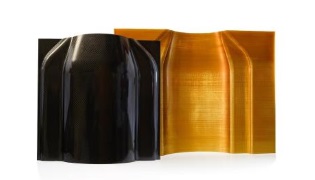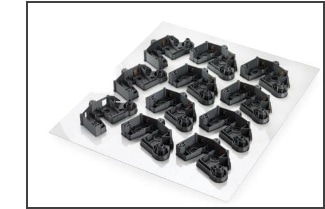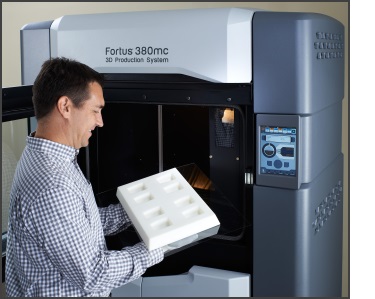Composite Tooling: Reducing Cost and Lead Time with Additive Manufacturing
 One of the biggest challenges in producing fiber reinforced polymer (FRP) composite structures has long been the cost and lead time involved in making the metal or sacrificial tooling used to lay up the composite structures. Additive manufacturing has been used for a number of years to produce composite layup tooling but was limited by the lack of materials capable of withstanding the temperatures used for curing composite structures.
One of the biggest challenges in producing fiber reinforced polymer (FRP) composite structures has long been the cost and lead time involved in making the metal or sacrificial tooling used to lay up the composite structures. Additive manufacturing has been used for a number of years to produce composite layup tooling but was limited by the lack of materials capable of withstanding the temperatures used for curing composite structures.
The Stratasys new ULTEM 1010 resin can be used at process parameters in excess of 350 degrees Fahrenheit, making it possible to use printed layup tooling for producing most composite structures. Switching from conventional manufacturing methods to additive manufacturing can reduce composite tooling fabrication expense and lead time by up to 90% while providing additional design freedom and weight savings.
Composite structures are normally built by applying composite laminate strips onto expensive molds or mandrels made of aluminum or steel that dictate the final part shape. Hollow parts with a configuration that traps the tooling inside require sacrificial tooling typically made of eutectic salts or cast urethanes. These are expensive to produce because additional tooling is required to build the sacrificial tooling.
Another option, is to produce the final part in two halves that are later bonded together. This approach requires additional assembly time and the resulting composite structure ends up with a seam that may weaken it.
Additive manufacturing eliminates the lengthy wait
Advanced Composite Structures previously paid around $2,000 to a machine shop to produce metal molds for composite layup and waited eight to ten weeks for delivery. Producing segmented aluminum tooling for a large belly pod fairing previously cost Aurora Flight Sciences $65,000 and took 7 weeks while the alternative of producing carbon epoxy tooling cost $95,000 and took 12 to 14 weeks. Swift Engineering had to wait 4 to 6 weeks for a machined or cast wash-out sacrificial tool assembly to be built by an outside supplier, making it difficult to meet customer delivery requirements.
 Additive manufacturing makes it possible to produce composite mold tooling without molds, tooling, or CNC programs, substantially reducing manufacturing costs and lead times. Additive manufacturing also eliminates the geometrical restrictions of conventional manufacturing methods, providing composite designers with virtually unlimited design freedom that often makes it possible to increase performance or reduce weight of the structure.
Additive manufacturing makes it possible to produce composite mold tooling without molds, tooling, or CNC programs, substantially reducing manufacturing costs and lead times. Additive manufacturing also eliminates the geometrical restrictions of conventional manufacturing methods, providing composite designers with virtually unlimited design freedom that often makes it possible to increase performance or reduce weight of the structure.
Fused Deposition Modeling improves competitive position
Advanced Composite Structures switched to producing nearly all its layup tools using additive manufacturing on a Fortus Fused Deposition Modeling (FDM) machine. A typical FDM layup tool costs only $400 and takes about 24 hours to produce. “For the repairs and short-volume production work that we specialize in, tooling often constitutes a major portion of the overall cost,” said Bruce Anning, owner of ACS. “Moving from traditional methods to producing composite tooling with FDM has helped us substantially improve our competitive position.”
 For example, ACS recently built the layup tool for a camera fairing directly from a CAD drawing. In another example, the geometry of a vertical fin assembly for a helicopter is so simple that a layup mandrel was not needed. However, the Fortus machine produced a drill fixture to accurately locate a series of holes.
For example, ACS recently built the layup tool for a camera fairing directly from a CAD drawing. In another example, the geometry of a vertical fin assembly for a helicopter is so simple that a layup mandrel was not needed. However, the Fortus machine produced a drill fixture to accurately locate a series of holes.
Aurora Flight Sciences was called upon by a key customer to design and produce a large belly-pod fairing in a very short timeframe. The company segmented the tooling for the fairing to fit the chamber of a Fortus FDM machine. This approach allowed the critical, trapped cylindrical section of the tool to drop down out of the part easily after lay-up and curing. The tooling cost was reduced by 65% to 75% and the lead time by 60% to 80% compared to the alternatives of aluminum and carbon epoxy tooling respectively.
Start producing tooling in a fraction of the time
Additive manufacturing also dramatically simplifies the process of making tooling for complex composite parts with hollow interiors. FDM sacrificial tooling is built with a special fill pattern that provides the mechanical strength to stand up to the layup process and form a material that withstands cure temperatures. After the part has been cured, the tooling can be easily removed by submerging the part and tool in the support removal detergent system. Additive manufacturing can produce sacrificial tooling in a fraction of the time and cost involved in traditional methods.
Swift Engineering reduced the lead time for tool production up to 70% by replacing multi-piece bonded assemblies with sacrificial tooling produced with additive manufacturing. Now, as the part is designed, a corresponding one-piece sacrificial tool is designed and printed with Stratasys ST-130 material using a custom-designed fill pattern that can withstand consolidation pressures in excess of 90 pounds per square inch. The sacrificial tool is easily dissolved after curing, eliminating secondary processes and accelerating composite part fabrication.
Fisher Unitech can help you seamlessly convert to printed composite tooling by guiding you through the selection process and providing telephone support, software releases and updates, free exchange of parts, and on-site service calls. This is the second in a series of blog posts in which we will discuss the advantages of using additive manufacturing to produce different types of manufacturing aids.

 Blog
Blog